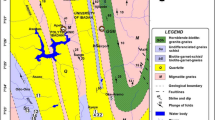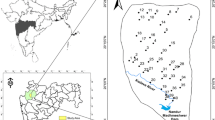Abstract
Geochemical mobilization of heavy metals in water has been cited as an important factor in many diseases of Sohag Governorate, Egypt. Forty-two groundwater samples were collected from the Quaternary aquifer and eight samples from surface water of Sohag governorate. The results recorded high contamination with cadmium and lead. Besides, about 50 % of samples are contaminated with iron and manganese at an alert level. All the metals under study exhibited an asymmetric statistical distribution in the investigated area. The study identified positive relationship between contaminated water (surface and groundwater) of Sohag with Cd (r s = 0.43) as well as Pb (r s = 0.21) and renal failure rate (R.F.R. = 26 patients/105 capita). The spatial distribution of these two metals (Cd and Pb) showed that they accumulated in the southern part of Sohag Governorate around Albalina District and in the northwestern part at Gehina District, which have the highest R.F.R. This study highlighted the need for more detailed research to assess the different pollutants and their relation to chronic diseases.







Similar content being viewed by others
References
Abdel Hammed MAA (2006) Kidney failure in Sohage Governorate (a study in medical geography). M.Sc. thesis, Geogr. Dept., Fac. Arts., Menya Univ., Egypt
Abdel Moneim AA (1999) Geoelectrical and hydrogeological investigations of the groundwater resources on the area to the west of the cultivated land at Sohag, Upper Egypt. Egypt J Geol 43(2):253–268
Adepoju-Bello AA, Alabi OM (2005) Heavy metals: a review. Niger J Pharm 37:41–45
Afolabi OM, Ajayi IR, Fayose RS, Olubosede O, Sunday AG (2011) Arsenic, nickel and iron concentration levels in water samples from hand-dug wells from Ugbe Akoko. Am J Appl Sci 8(2):182–185
Ahmed AA (2007) Using contamination and pesticide drastic GIS-based models for vulnerability assessment of Quaternary Aquifer at Sohag, Egypt. The 5th Intern. Conf Geol Africa (1): 29–47 (Oct. 2007), Assiut-Egypt
Alloway BJ (1990) Heavy metals in soils. Blackie, Glasgow, pp 7–40, 100–219, 261–77
Alloway B, Ayres DC (1997) Chemical principals of environmental pollution, 2nd edn. Chapman and Hall, London, 395p
Anton M, Rojas MB, Aluculesei A, Marguta R, Dorohoi D (2008) Study regarding the water pollution with heavy metals in Romania and Spain. Rom J Physiol 53(1–2):157–163
Apello CAJ, Postma D (1993) Geochemistry, groundwater and pollution, 4th edn. Balkema, Rotterdam
APHA (1998) Standard method for the examination of water and wastewater, 20th edn. American Public Health Association, Washington, DC
Attia FR (1974) Parameter and characteristics of the groundwater reservoir in Upper Egypt. M.Sc. thesis, Fac Eng, Cairo Univ, Egypt, 164p
Attia FR, Allam MN, Amer MA (1986) A hydrologic budget analysis for the Nile Valley in Egypt. Bull Fac Eng Cairo Univ 24(4):453–459
Ayazi MH, Pirasteh S, Arvin AKP, Pradhan B, Nikouravan B, Mansor S (2010) Disasters and risk reduction in groundwater: Zagros Mountain Southwest Iran using geoinformatics techniques. Disaster Adv 3:51–57 (ISI, IF: 0.478)
Bandara JMRS, Seneviratna DMAN, Dassanayaka DMRSB, Herath V, Bandara JMRP, Abeysekara T, Rajapaksha KH (2008) Chronic renal failure among farm families in cascade irrigation systems in Sri Lanka associated with dietary cadmium levels in rice and freshwater fish (Tilapia). Environ Geochem Health 30:465–478
Berman E (1980) Toxic metals and their analysis. Hayden, Philadelphia
Butzer KW, Hensen CL (1968) Desert and river in Nubia, geomorphology and prehistoric environments at the Aswan reservoir. University of Wisconsin Press, Madison
Caravati ME (2004) Arsenic and arsine gas. In: Dart RC (ed) Medical toxicology. Lippincott Williams and Wilkins, Philadelphia, pp 1393–1401
Cavazza S, Pagliara S (2000) Groundwater and surface water interactions. In: EOLSS Encyclopedia of Life Support System, p 1, UNESCO, tot.pag. 17
Cox PA (1997) The elements on earth: inorganic chemistry in the environment. Oxford, New York, 288p
Donato F, Monarca S, Premi S, Gelatti U (2003) Drinking water hardness and chronic degenerative diseases. III. Tumors, urolithiasis, fetal malformations, deterioration of the cognitive function in the aged and atopic eczema. Ann Ig 15(1):57–70
Erikson KM, Dobson AW, Dorman DC, Aschner M (2004) Manganese exposure and induced oxidative stress in the rat brain. Sci Total Environ 334–335:409–416
Farrag AA (2005) The hydraulic and hydrochemical impacts of the Nile system on the groundwater in Upper Egypt. Ass Univ Bull Environ Res 8 (1)
Farrag AF (2011) Application of geoelectric resistivity measurements for groundwater exploration at some localities in Sohag Governorate, Egypt. M.Sc. thesis, Geol Dept, Fac Sci, Al-Azhr Univ
Fosmire GJ (1990) Zinc toxicity. Am J Clin Nutr 51:225–227
Ghazy SE (1995) Removal of cadmium, lead, mercury, tin, antimony, and arsenic from drinking and seawaters by colloid precipitate flotation. Sci Technol 30:933–947
Hammer MJ, and Hammer Jr (2004) Water quality. In: Water and wastewater technology, 5th edn. Prentice-Hall, Upper Saddle River, pp 139–159
Harambat J, van Stralen KJ, Kim JJ, Tizard EJ (2012) Epidemiology of chronic kidney disease in children. Pediatr Nephrol 27:363–373
Hein MS (2003) Copper deficiency anemia and nephrosis in zinc-toxicity: a case report. SDJ Med 56(4):143–147
Hesterberg D (1998) Biogeochemical cycles and processes leading to changes in mobility of chemicals in soils. Agric Ecosyst Environ 67(2):121–133
Jennings GD, Sneed, RE, Clair MBS (1996) Metals in drinking water. North Carolina Cooperative Extension service Publication no: AG-473-1. Electronic version 3/1996
Johri N, Jacquillet G, Unwin R (2010) Heavy metal poisoning: the effects of cadmium on the kidney. Biometals 23:783–792
Kesse GO (1985) The mineral and rock resources of Ghana. Balkema, the Netherlands
Klaassen CD, Watkins JB (2010) Casarett and Doull's essentials of toxicology, 2nd edn. McGraw-Hill, New York, p 472. ISBN-10: 0071622403
Krishna AK, Govil PK (2005) Heavy metal distribution and contamination in soils of Thane Belapur industrial development area, Mumbai, Western India. Environ Geol 47:1054–1061
Langmuir P (1997) Aqueous environment geochemistry. Prentice-Hall, USA, 600 p
Lauwerys RR (1979) Health effects of cadmium. In: Di Ferrante E (ed) Trace metal: exposure and health effects. Pergamon, Oxford, pp 43–64
Manap MA, Nampak H, Pradhan B, Lee S, Sulaiman WNA, Ramli MF (2012a) Application of probabilistic-based frequency ratio model in groundwater potential mapping using remote sensing data and GIS. Arab J Geosci (article online first available). doi:10.1007/s12517-012-0795-z
Manap MA, Sulaiman WNA, Ramli MF, Pradhan B, Surip N (2012b) A knowledge driven GIS modelling technique for prediction of groundwater potential zones at the Upper Langat Basin, Malaysia. Arab J Geosci (article on-line first available). doi:10.1007/s12517-011-0469-2
Mendie U (2005) The nature of water. In: The theory and practice of clean water production for domestic and industrial use. Lacto-Medals, Lagos, pp 1–21
Mostafa HA (1979) Geological studies on the area northeast of Sohag. M.Sc. thesis, Geol. Dept., Fac Sci, Sohag, Assiut Univ
Needleman HL (1993) The current status of childhood low-level lead toxicity. Neurotoxicology 14:161–166
Omer AAM (1996) Geological, mineralogical and geochemical studies on the Neogene and Quaternary Nile basin deposits, Qena-Assiut stretch, Egypt. Ph.D. thesis, Geol Dept, Fac Sci, South Valley Univ
Omer AAM (2003) Impact of the Pleistocene Nile basin sediments on the distribution of iron and manganese in the groundwater, Tema-Nag Hammadi area, Nile Valley, Egypt. The 3rd Intern Conf Geol Africa, 1, pp 21–37 (Dec. 2003), Assiut-Egypt
Omer AAM, Issawi B (1998) Lithostratigraphical, mineralogical and geochemical studies on the Neogene and Quaternary Nile basin deposits, Qena-Assiut stretch, Egypt. The 4th Intern Conf Geol Arab World, Cairo. (Abstract)
Omran AA, Korany EA, Abdel-Rahman AA (2006). An integrated approach to evaluate groundwater potentiality—a case study. Proc. of the 3rd Int. Conf. of Applied Geophysics, ESAP, 18–20 March 2006, National Research Center, Cairo, Journal of Applied Geophysics 5 (1), pp 1–16
Orisakwe OE, Igwilo IO, Afonne OJ, Maduabuchi JU, Obi E, Nduka JC (2006) Heavy metal hazards of sachet water in Nigeria. Arch Environ Occup Health 61(5):209–213
Priestley AJ (2002) Report on sewage sludge treatment and disposal environmental problems and research needs from an Australian prospective. CSIRO, Division of Chemicals and Polymers, Clayton, 48 p
Said R (1960) Planktonic foraminifera from the Thebes Formation, Luxor, Egypt. Micropaleontology 16:227–286
Said R (1971) Explanatory notes to accompany the geological map of Egypt 1:2,000,000.Geol Surv Egypt. Paper 56, 123p
Said R (1981) The geological evolution of the River Nile Springer Verlag. Heidelberg, New York, 151p
Salem HM, Eweida EA, Farag A (2000) Heavy metals in drinking water and the environmental impact on human health. ICEHM, Cairo, pp 542–556
Salequzzaman M, Tariqul Islam SM, Tasnuva A, Kashem MA, Mahedi Al Masud M (2008) Environmental impact of sugar industry—a case study on Kushtia sugar mills in Bangladesh. J Innov Dev Strat 2(3):31–35
Salman SA (2013) Geochemical and environmental studies on the territories West River Nile, Sohag Governorate—Egypt. Ph.D. thesis, Fac Sci, Al-Azhar Univ, Egypt, 314 p
Toufeek MEF (2011) Distribution of cadmium and lead in Aswan Reservoir and River Nile water at Aswan. World App Sci J 13(2):369–375
Trick JK, Stuart M, Reeder S (2008) Contaminated groundwater sampling and quality control of water analyses. In: Vivo DE et al (eds) Environmental geochemistry site characterization, data analysis and case histories. Elsevier, London, pp 29–57
Wan Ngah WS, Hanafiah MAKM (2008) Removal of heavy metal ions from wastewater by chemically modified plant wastes as adsorbents. Rev J Bioresour Technol 99:3935–3948
Wang M, Xu Y, Pan S, Zhang J, Zhong A, Song H, Ling W (2010) Long-term heavy metal pollution and mortality in a Chinese population: an ecologic study. Biol Trace Elem Res 1–18
Warner JW, Gates TK, Attia FA, Mankarious WF (1991) Vertical leakage in Egypt’s Nile Valley: estimation and implication. J Irrig Drain Eng 117(4):515–533
WHO (2007) Water for pharmaceutical use. In: Quality assurance of pharmaceuticals: a compendium of guidelines and related materials, 2nd updated edn, vol 2. World Health Organisation, Geneva, pp 170–187
WHO (2011) Guideline for drinking water quality. Recommendations, 4th edn. World Health Organization, Geneva
Youssef AA, Omer AA, Ibrahim MS, Ali MH, Cawlfield JD (2009) Geotechnical investigation of sewage wastewater disposal sites and use of GIS land use maps to assess environmental hazards: Sohag, upper Egypt. Arab J Geosci. doi:10.1007/s12517-009-0069-6
Yule W, Rutter M (1985) Effect on children’s behavior and cognitive performance: a critical review. In: Mahaffey R (ed) Dietary and environmental lead (Pb): human health effects. Elsevier, New York, pp 211–251
Zhang WJ, Jiang FB, Ou JF (2011) Global pesticide consumption and pollution: with China as a focus. Proc Int Acad Ecol Environ Sci 1(2):125–144
Zietz BP, Lap J, Suchenwirth R (2007) Assessment and management of tap water lead contamination in Lower Saxon, Germany. Int J Environ Health Res 17(6):407–418
Author information
Authors and Affiliations
Corresponding author
Rights and permissions
About this article
Cite this article
Melegy, A.A., Shaban, A.M., Hassaan, M.M. et al. Geochemical mobilization of some heavy metals in water resources and their impact on human health in Sohag Governorate, Egypt. Arab J Geosci 7, 4541–4552 (2014). https://doi.org/10.1007/s12517-013-1095-y
Received:
Accepted:
Published:
Issue Date:
DOI: https://doi.org/10.1007/s12517-013-1095-y




